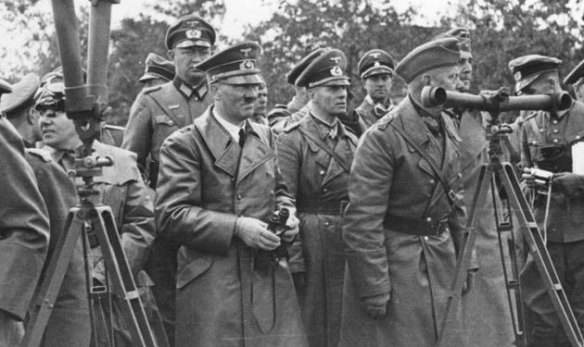Rommel with Hitler in Poland, 1939.
Hitler and Generalmajor Erwin Rommel at an airfield of the Army Group South in the area Rawa / Tomaszow, September 11 1939. Rommel is commander of the Führerbegleitbrigade battalion, tasked with guarding Hitler and his field headquarters during the invasion of Poland.
Erwin Rommel was furious. Only three days after German forces invaded Poland, Hitler, arriving aboard his special train, was visiting the front. He wanted a tour of the battlefields, so he, his staff, and various official escorts, Rommel included, packed into seven heavy-duty Mercedes automobiles (equipped with not four, but six wheels).
The small motorcade was led into the danger zones by two armored scout cars. Following close behind was a huge column of seventy additional vehicles carrying the Führer’s entourage of Nazi Party hacks and governmental “dignitaries,” all anxious to have lead positions. At stopping points, they rushed from their cars for photographs at Hitler’s side if at all possible, then ran pell-mell back to their autos for the next lap in the journey to Fourth Army headquarters—and for further jockeying for position in the convoy.
Since the rough and primitive back roads of Poland were not built for such traffic, clouds of dust roiled up in protest.
Rommel was Hitler’s headquarters commandant at the time, and when Hitler’s infamous secretary Martin Bormann complained about the unruly motorcade activities, Rommel shot back: “I’m not a kindergarten teacher. You sort them out if you want!”
That was on September 4, 1939, three days after the war’s start, but by September 20, the same sort of fawning behavior was still going on. By then, Hitler had moved from his train to the Casino Hotel in Zoppot.
Watching in considerable astonishment was the German General Walter Warlimont, a visitor to the Hitler headquarters. As he looked on one morning, twenty to thirty cars were assembled “two abreast” in the hotel driveway for a trip to a battle area north of Gdingen. “It was the job of General Rommel, the Headquarters Commandant, to get this cortege moving, with Hitler at its head,” wrote Warlimont.
When Warlimont asked Rommel why two abreast, “Rommel replied that, after many unhappy experiences, he had laid on this ‘order of march’ because it offered the best hope of satisfying the precedence and protocol requirements of the large number of non-military visitors who had meanwhile flowed into the headquarters.”
Thus, with cars two abreast, six or eight exalted personages could travel “level with each other and at the same distance from Hitler, and for them that was more important than anything.”
But Rommel’s best-laid plans went awry that very day. “The cortege went down a narrow track where the two-abreast formation was no longer possible and the majority of the cars were held up at a barrier while Hitler and the leaders drove on.”
Even though word was passed among those left behind that the tour had been interrupted for a quick Hitlerian visit to a field hospital, Bormann, for one, was again outraged. “Nevertheless, although they were almost on the battlefield, Martin Bormann, the Head of the Party Chancellery, made a fearful scene and cursed General Rommel in outrageous language because of the supposed slight inflicted on him.’’
Once again, the future “Desert Fox” was fuming. But he had to hold his tongue. “There was nothing Rommel could do in answer to such insolence. When I straightaway gave vent to my indignation…Rommel merely asked me to tell Schumndt, the senior military aide, equally forcibly what I thought about it.”
Based upon Inside Hitler’s Headquarters, 1939–45 by Walter Warlimont (Weidenfeld and Nicolson, London, 1964) and Hitler’s War by David Irving (Hodder and Stoughton, London, 1977).
